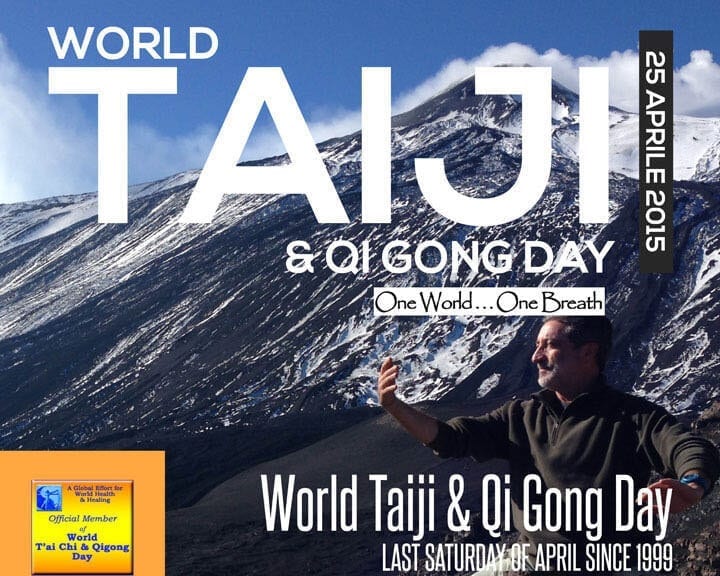Pacific College of Oriental Medicine is one institution or global healing center of many around the world to recognize World Tai Chi and Qigong Day (WTCQD). Beginning at 10 a.m. April 30 in New Zealand and spreading across time zones, World Tai Chi and Qigong Day will see people in over 80 nations gather at a park, global healing center or back yard to practice these disciplines.
World Tai Chi and Qigong Day provides teachers, schools and Tai Chi and Qigong exercise associations with many free tools and services to educate communities about the potential benefits of these disciplines. It is also a day to promote worldwide wellbeing.
“The idea is to create a wave of health and healing throughout the planet,” said Robert Nations, a faculty member and Qigong/Tai Chi specialist at Pacific College of Oriental Medicine. “Within the Chinese medical community it is a time for quiet contemplation on the reason we are here in the first place.”
THE ORIGINS AND EVOLUTION OF WORLD TAI CHI AND QIGONG DAY
The first WTCQD began eight years ago in Kansas City . Angela Wong Douglas and Bill Douglas were the forerunners in the effort to begin WTCQD. Angela grew up in Hong Kong Island ‘s Causeway Bay . As a girl she observed her mother practicing Tai Chi everyday and went on to take a Tai Chi class with master Jennifer Booth at Orange Coast College ‘s Oriental medicine school . Through World T’ai Chi & Qigong Day Angela feels she works to share the wisdom she has learned with the entire world.
Bill Douglas is an American Tai Chi teacher, author, and columnist who writes on natural health and global healing issues. He has founded two global healing events, and works with Tai Chi & Qigong exercise teachers worldwide to facilitate the use of these tools globally in health care, corporate wellness, and education.
“World Tai Chi and Qigong Day is a loose, fun, flowing and profoundly effective global celebration and media/educational event,” said Douglas . “It was created by people world wide who have experienced the joy and healing of Tai Chi and Qigong exercise health sciences and now, for the love of humanity, want to share them.”
The Philosophical and Cultural Significance of Tai Chi and Qigong
Qigong exercise has a long history. In ancient China , people believed that through controlled body movements and mental concentration, paired with various breathing techniques, they could balance and enhance physical, metabolic and mental functions. There are thousands of different styles and schools of Qigong. Oriental medicine school or Qigong exercise schools generally teach their own variations of physical training routines based on coordinating patterns of breathing with different physical motions of the body. Qigong exercise relies on the traditional Chinese belief that the body has an energy field, known as Qi . “Qi” in Mandarin Chinese means breath or to breathe and “gong” means work or technique. The pairing of the two is the basis for the art of Qigong.
Tai Chi is also a centuries-old Chinese discipline that aids health, relaxation, balance, flexibility, strength, meditation, self-defense and self-cultivation. It is referred to as moving meditation. The practice began as a martial art and is based on the principles of the Yin Yang symbol, called Tai Chi in Chinese, meaning “grand ultimate.” Now the practice can be found in any global healing center .
There are a number of so-called forms taught at a global healing center or Oriental medicine school — sometimes also called ‘sets’ which consist of a sequence of movements. In the early history of Tai Chi, most of the information on the art was held tightly with in the particular Tai Chi families. It was only taught to the immediate family members including daughters in-law, but never to the daughter. The reason being that the daughter married outside the family and no one outside the family was told anything about the fighting arts of that family.
If you think a career in holistic medicine is something you would like to pursue, contact us and speak to an admissions representative to get started on your new journey!
THE GLOBAL IMPACT AND PARTICIPATION IN WTCQD
World Tai Chi and Qigong Day has brought a sense of shared community to these arts, and is not exclusively for members of the Chinese medical community or those who are a part of an Oriental medicine school . “One does not need to know forms of Tai Chi or Qigong to participate,” said Nations. “At 10 a.m. April 30, wherever you are, just relax your body, quiet your mind and follow your breath deeply into your lower abdomen.”
Activities at most events include Tai Chi and Qigong exercise demonstrations, and many feature prominent masters leading exercises. Events are free and open to the public. A good way to find events in your area is to check with the nearest Oriental medicine school or global healing center . In stressful times such as these, a day such as WTCQD is much needed. It can bring both relaxation and a sense of community and shared peace. It also brings people together across economic and geopolitical lines to celebrate health and healing.
“World Tai Chi and Qigong Day is an opportunity for an individual regardless of nationality, religion, political affiliation, economic status, race age or ability to participate in a worldwide event,” said Nations. “It is individuals consciously connecting with others everywhere with the universal force of Qi.”
Featured Posts:

